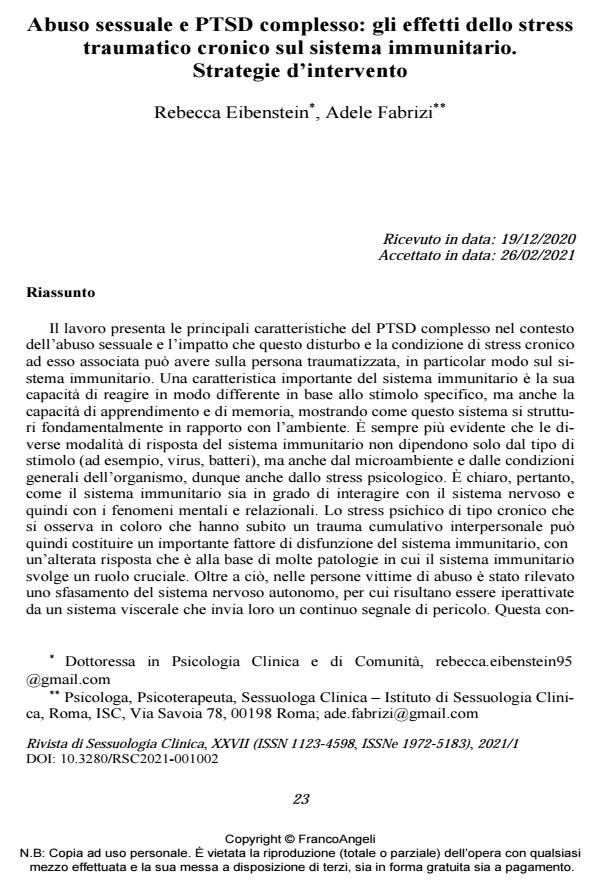Abuso sessuale e PTSD complesso: gli effetti dello stress traumatico cronico sul sistema immunitario. Strategie d’intervento
Titolo Rivista RIVISTA DI SESSUOLOGIA CLINICA
Autori/Curatori Rebecca Eibenstein, Adele Fabrizi
Anno di pubblicazione 2021 Fascicolo 2021/1
Lingua Italiano Numero pagine 21 P. 23-43 Dimensione file 225 KB
DOI 10.3280/RSC2021-001002
Il DOI è il codice a barre della proprietà intellettuale: per saperne di più
clicca qui
Qui sotto puoi vedere in anteprima la prima pagina di questo articolo.
Se questo articolo ti interessa, lo puoi acquistare (e scaricare in formato pdf) seguendo le facili indicazioni per acquistare il download credit. Acquista Download Credits per scaricare questo Articolo in formato PDF

FrancoAngeli è membro della Publishers International Linking Association, Inc (PILA)associazione indipendente e non profit per facilitare (attraverso i servizi tecnologici implementati da CrossRef.org) l’accesso degli studiosi ai contenuti digitali nelle pubblicazioni professionali e scientifiche
Il lavoro presenta le principali caratteristiche del PTSD complesso nel contesto dell’abuso sessuale e l’impatto che questo disturbo e la condizione di stress cronico ad esso associata può avere sulla persona traumatizzata, in particolar modo sul sistema immunitario. Una caratteristica importante del sistema immunitario è la sua capacità di reagire in modo differente in base allo stimolo specifico, ma anche la capacità di apprendimento e di memoria, mostrando come questo sistema si strutturi fondamentalmente in rapporto con l’ambiente. È sempre più evidente che le diverse modalità di risposta del sistema immunitario non dipendono solo dal ti-po di stimolo (ad esempio, virus, batteri), ma anche dal microambiente e dalle condizioni generali dell’organismo, dunque anche dallo stress psicologico. È chiaro, pertanto, come il sistema immunitario sia in grado di interagire con il sistema ner-voso e quindi con i fenomeni mentali e relazionali. Lo stress psichico di tipo croni-co che si osserva in coloro che hanno subito un trauma cumulativo interpersonale può quindi costituire un importante fattore di disfunzione del sistema immunitario, con un’alterata risposta che è alla base di molte patologie in cui il sistema immunitario svolge un ruolo cruciale. Oltre a ciò, nelle persone vittime di abuso è stato rilevato uno sfasamento del sistema nervoso autonomo, per cui risultano essere iperattiva-te da un sistema viscerale che invia loro un continuo segnale di pericolo. Questa condizione ha importanti ripercussioni anche sulla capacità interattiva e sociale, con un grave impatto sul benessere psicofisico della persona. Per questo motivo, è necessario sviluppare interventi basati su un approccio multidisciplinare e biopsi-cosociale che aiutino le persone traumatizzate a risintonizzare la regolazione au-tonomica per favorire la fiducia e un coinvolgimento sociale spontaneo, e ad ela-borare le componenti emotive e somatiche dell’esperienza traumatica.
Parole chiave:PTSD complesso, stress cronico, abuso sessuale, immunità, disrego-lazione immunitaria, infiammazione.
Rebecca Eibenstein, Adele Fabrizi, Abuso sessuale e PTSD complesso: gli effetti dello stress traumatico cronico sul sistema immunitario. Strategie d’intervento in "RIVISTA DI SESSUOLOGIA CLINICA" 1/2021, pp 23-43, DOI: 10.3280/RSC2021-001002